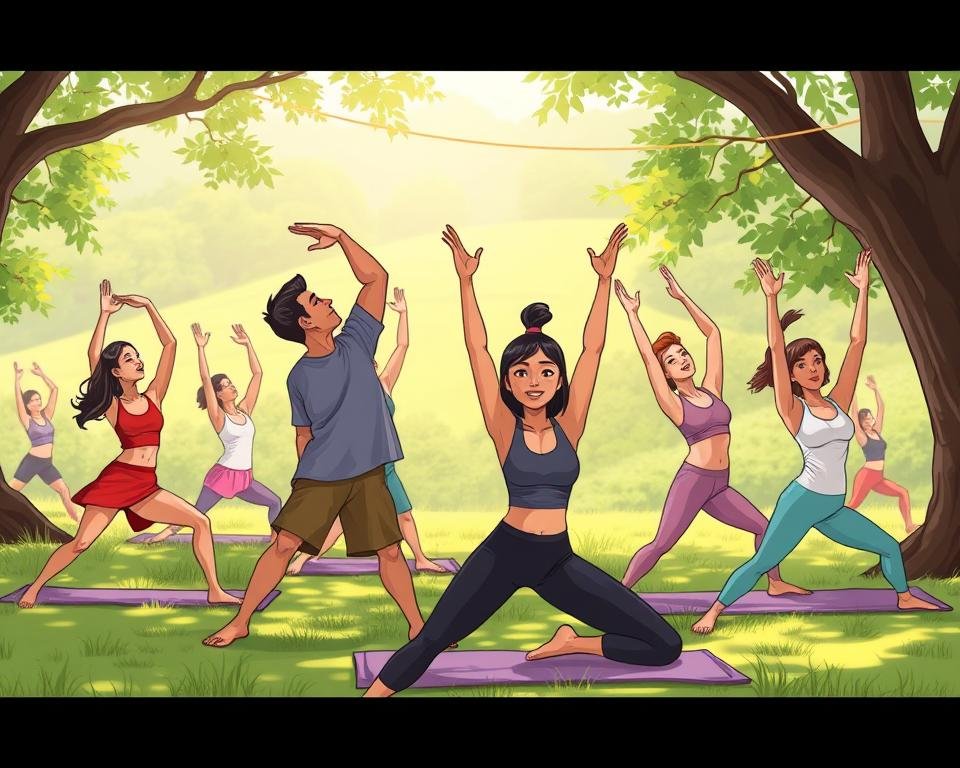Stretching is a key part of any fitness plan, but does it really burn calories? The answer is a bit complex. The American Council says a 150-pound person might burn about 85 calories stretching or doing hatha yoga for 30 minutes. This might not seem like a lot, but stretching offers many benefits beyond just losing weight.
As we get older, many people lose the ability to touch their toes. This shows how important stretching is for staying flexible and functional. Dr. Nicole Lombardo points out that dynamic stretches or yoga flows can burn more calories than just sitting. This means adding stretching to your daily routine can help you burn more calories, even if it’s not the main way to lose weight.
Stretching might not burn as many calories as intense activities like jogging or interval training. Yet, it’s a valuable part of your fitness journey. Knowing how stretching affects calorie burn helps you use it to support your health and weight goals.
Understanding the Relationship Between Stretching and Calorie Burn
When you think about losing weight by stretching, it’s key to know the different stretching types. Each type affects how many calories you burn. Adding stretching to your fitness routine can boost your health and wellness.
Different Types of Stretching Activities
There are two main stretching types: static and dynamic. Static stretching means holding a stretch for 15 to 60 seconds. It makes your muscles more flexible. Dynamic stretching uses controlled movements to make your muscles and joints more flexible.
How Energy Expenditure Works During Stretching
Stretching can burn 90 to 180 calories per hour. This adds to your daily calorie burn. The more intense and longer the stretch, the more calories you’ll burn. Stretching also boosts blood flow, helping with nutrient delivery and waste removal, which is good for your heart.
Factors Affecting Calorie Burn While Stretching
Several things can change how many calories you burn while stretching. These include your weight, the type of stretch, and your metabolism. You can stretch anywhere, burning calories without needing a gym. Doing this regularly can help you manage your weight and stay healthy.
Remember, stretching alone might not change your body shape much. But it’s great for a balanced fitness routine. Adults should do at least 150 minutes of moderate exercise or 75 minutes of vigorous exercise weekly. They should also do muscle-strengthening activities at least 2 times a week.

“Stretching can be a powerful tool in supporting overall fitness goals, but it should be combined with other physical activities and a balanced diet for optimal weight management.”
Does Stretching Burn Calories: The Scientific Evidence
Stretching may not burn as many calories as other exercises, but it does help. A 150-pound person can burn about 90-120 calories in 30 minutes of stretching, says the American Council on Exercise.
Stretching burns fewer calories than intense activities like running or cycling. This is because it involves slow movements that relax muscles, not intense muscle work. Also, stretching sessions are usually short, which lowers the calorie burn.
The calories burned can change based on several things. These include your body type, the type of stretching, and how long you stretch. Stretching doesn’t work big muscles like strength training or cardio, which burn more calories.
Stretching might not be the best for burning calories or losing weight. But it’s key for a good fitness plan. It boosts flexibility, lowers injury risk, and improves mood, helping with fitness and weight goals.
“Stretching does not significantly challenge or engage large muscle groups like those used during strength training or aerobic exercises, which contribute to higher calorie burns.”
In summary, stretching does burn calories, but it’s not the best for weight loss. Yet, adding stretching to your routine has many health benefits. The goal is to mix different exercises for a balanced fitness plan.
Caloric Expenditure Based on Body Weight
Your body weight is key when it comes to burning calories through stretching. The energy you use can change a lot based on your size and muscle mass.
A 125-pound person might burn about 70 calories in 30 minutes of stretching. On the other hand, someone who weighs 150 pounds could burn around 85 calories. If you weigh 200 pounds, you could burn up to 113 calories in the same time.
Duration Impact on Calorie Burn
The length of your stretching session also matters a lot. Longer sessions burn more calories. For instance, stretching for 5 minutes can burn 14-18 calories. Stretching for 15 minutes can burn 40-55 calories. And stretching for 30 minutes can burn 80-120 calories.
| Body Weight | Calories Burned in 30 Minutes of Stretching |
|---|---|
| 125 pounds | 70 calories |
| 150 pounds | 85 calories |
| 200 pounds | 113 calories |
Knowing how your body weight, stretching time, and calorie burn are connected helps you plan better. This way, you can make your stretching routine more effective for weight management.
Static vs Dynamic Stretching: Which Burns More Calories?
The type of stretching you do can affect how many calories you burn. Dynamic stretching, which involves moving, is better at burning calories than static stretching.
A 155-pound person can burn about 149 calories in 30 minutes with active stretching. For a 120-pound person, it’s around 120 calories. A 200-pound person can burn 178 calories in the same time.
Dynamic stretching can burn between 135 and 200 calories in half an hour. This is because it uses more muscles and movement, which burns more energy.
Static stretching, like sitting or lying on the floor, burns fewer calories. A 155-pound person can burn about 42 calories in half an hour of static stretching.
Both static and dynamic stretching are important for flexibility, injury prevention, and better exercise performance. But if you want to burn more calories, choose dynamic stretching.
Regular stretching, whether static or dynamic, is key for good range of motion. This is what the International Journal of Sports Physical Therapy says.
To get the most from stretching, mix dynamic and static stretches in your workouts. Aim to stretch all major muscle groups at least three times a week.
The Role of Stretching in Weight Management
While stretching may not directly lead to significant weight loss, it’s vital for an active lifestyle. It boosts mobility and flexibility. This helps you move more during the day, which is key for weight management.
NEAT and Daily Movement Benefits
NEAT stands for calories burned through daily activities like walking and doing chores. Adding stretching to your day can increase your NEAT. This helps burn more calories and aids in weight control.
Long-term Impact on Weight Loss Goals
Stretching alone might not lead to big weight loss, but it supports other weight loss efforts. It improves your physical function and encourages an active lifestyle. This makes it easier to do various exercises, which are vital for lasting weight loss.
| Exercise Type | Average Calories Burned per Hour (for a 155-lb person) |
|---|---|
| Stretching (light) | 110-180 calories |
| Brisk Walking | 200-350 calories |
| Jogging | 500-700 calories |
| Swimming | 400-700 calories |
Mixing stretching with other exercises can help manage weight effectively. It focuses on calorie burn and physical health. An active lifestyle, with regular stretching, is key to reaching and keeping healthy weight goals.
“Stretching is an essential component of any well-rounded fitness program, as it helps improve flexibility, balance, and overall physical function – all of which can contribute to a more active and healthier lifestyle.”
Benefits Beyond Calorie Burning
Stretching is more than just burning calories. It offers many benefits that improve your health and happiness. These advantages go beyond just losing weight.
Improved Flexibility: Stretching makes your joints move better. This means you can do more without getting hurt. You’ll find it easier to move and exercise.
Reduced Stress: Stretching calms your mind and body. It helps you feel less stressed and anxious. The deep breathing and muscle relaxation help you feel better.
Better Posture: Stretching helps your posture by strengthening key muscles. Good posture looks great and can prevent back pain. It makes you look and feel better.
Enhanced Blood Circulation: Stretching boosts blood flow. This means more oxygen and nutrients for your muscles and organs. Better circulation improves your physical and mental health.
Injury Prevention: Stretching lowers the chance of muscle injuries. It’s great for warming up or cooling down. It’s perfect for those who do intense or high-impact exercises.
In summary, stretching does more than just burn calories. It improves flexibility, reduces stress, and enhances posture. It also boosts blood circulation and prevents injuries. These benefits make stretching a key part of a healthy lifestyle.
“Stretching is an essential component of any well-rounded fitness program, providing a range of physical and mental benefits that go beyond just calorie burning.”
Incorporating Stretching into Your Fitness Routine
Stretching is a simple yet powerful tool that can be seamlessly integrated into your daily fitness routine. Whether you’re aiming to lose weight by stretching or enhance your overall well-being, making stretching a consistent part of your lifestyle can yield remarkable benefits.
Morning Stretching Routines
Starting your day with a few minutes of gentle stretching can set the tone for a more active and energized day. Simple stretches like neck rolls, shoulder shrugs, and leg swings can help awaken your muscles and improve blood circulation, preparing your body for the activities ahead. Dedicating just 10-15 minutes to a morning stretching routine can burn up to 41 calories and leave you feeling refreshed and ready to tackle the day.
Post-Workout Flexibility Training
Integrating stretching into your post-workout routine is essential for aiding in recovery and maintaining flexibility. Techniques like PNF (Proprioceptive Neuromuscular Facilitation) stretching can help trigger the myotatic reflex, improving range of motion and reducing muscle tension. Static stretches, where you hold a pose for at least 60 seconds, can also be beneficial in decreasing overall muscle tightness.
Consistency is key when it comes to reaping the benefits of stretching for weight loss. Aim to incorporate 2-3 stretching sessions per week, whether it’s during your morning routine or after a workout. Even simple desk stretches throughout the day can contribute to your overall daily movement and calorie expenditure.
By making stretching a regular part of your fitness regimen, you’ll not only burn calories and improve flexibility, but you’ll also enhance your overall exercise performance, reduce the risk of injuries, and support your long-term weight loss goals.
How Stretching Enhances Overall Exercise Performance
Stretching is key to a good exercise routine. It boosts flexibility and range of motion. This lets your muscles work better during activities, helping you burn more calories and reach your weight loss goals.
Stretching also lowers injury risk. Flexible muscles are less prone to strains and tears. This means you can keep exercising regularly, leading to better fitness and weight loss.
Stretching makes muscles work better and with better form. This results in more effective workouts. You might burn more calories during your sessions.
“Regular stretching improves daily performance, aiding in sports activities, enhances flexibility for everyday movements, and preventing injuries, muscle weakness, and headaches.”
To get the most from stretching, target major muscle groups. Add sport-specific stretches to your routine. Remember to stretch safely by avoiding bounces and breathing right.
Regular stretching boosts your workout’s effectiveness. It supports your fitness goals, including does stretching help you lose weight. It improves flexibility, reduces injury risk, and enhances exercise performance. This leads to a healthier, more active life.
Common Misconceptions About Stretching and Weight Loss
Many people think stretching is key for weight loss. While stretching can burn some calories, it’s not enough to make a big difference in weight or body shape.
Static stretching, holding a stretch for a long time, doesn’t burn many calories. Dynamic stretching, which is moving while stretching, is better for warming up. It might also burn a few more calories.
Remember, exercise alone is not enough for weight loss. Eating right is also key. Stretching is good for fitness, but it can’t replace a healthy diet for losing weight.
| Comparison of Calorie Burn | Time Required |
|---|---|
| Burning off a Donut | 30 minutes of exercise |
| Burning off a Big Mac | 1 hour and 40 minutes |
Some think stretching can target fat in specific areas. But, exercise burns fat all over, not just where you stretch. Strength training is often better for losing weight than cardio.
Stretching is good for fitness and helps with weight loss by improving movement and reducing injuries. But, it’s just one part of a good fitness plan, not the only way to lose weight by stretching.
Best Stretching Exercises for Maximum Benefits
Adding the right stretches to your workout can bring many benefits. You’ll see better flexibility, less muscle tension, and improved sports skills. It also boosts your overall health. Whether you want to burn more calories or stay mobile as you get older, stretching is essential.
Full Body Stretches
Try full-body stretches like the crescent moon stretch and yoga-inspired spinal rolls. These moves work many muscles at once. They help you stay flexible and relieve tension all over.
Targeted Area Exercises
Focus on stretches for tight spots like your neck, shoulders, chest, hips, and inner thighs. This targets specific areas to boost mobility and lower injury risk. It’s great for anyone looking to lose weight through stretching or just get fitter.
Doing a mix of full-body and targeted stretches for 10 minutes a day can change your flexibility and muscle recovery. Make stretching a regular part of your life. This way, you’ll get the most out of this important fitness practice.
FAQ
Does stretching burn calories?
Yes, stretching can burn calories. The amount depends on the type and how long you stretch. For example, a 150-pound person might burn about 85 calories in 30 minutes of stretching or hatha yoga.
What are the different types of stretching activities?
There are two main types of stretching. Static stretching is holding a position. Dynamic stretching involves active movements. Dynamic stretching usually burns more calories because it’s more active.
How does energy expenditure work during stretching?
The energy spent while stretching depends on how intense and long the activity is. Your body weight, the type of stretching, and your metabolism also play a role.
What factors affect calorie burn while stretching?
Several factors influence calorie burn during stretching. For instance, a 125-pound person might burn about 70 calories in 30 minutes. A 150-pound person could burn around 85 calories, and a 200-pound person might burn about 113 calories. Stretching for longer periods burns more calories.
What does the scientific evidence say about stretching and calorie burn?
Studies show that stretching does burn calories, but at a lower rate than intense exercises. The American Council on Exercise estimates calorie burn for stretching and yoga. Yet, it’s not the best way to lose weight.
How do static and dynamic stretching compare in terms of calorie burn?
Dynamic stretching burns more calories than static stretching because it’s more active. For example, dynamic stretches like arm circles or body-weight lunges can burn 135 to 200 calories in half an hour, depending on your weight. Static stretching burns fewer calories but helps with flexibility and energy expenditure
How does stretching support weight management?
Stretching helps with weight management by improving mobility and encouraging more movement. This boosts Non-Exercise Activity Thermogenesis (NEAT) and total daily calorie burn. While stretching alone may not lead to significant weight loss, it supports a more active lifestyle and can enhance other weight loss efforts.
What are the benefits of stretching beyond calorie burning?
Stretching offers many benefits beyond calorie burning. It improves flexibility, reduces stress, and enhances blood circulation. Regular stretching can also lower injury risk during other exercises, improve range of motion, and contribute to better physical performance and well-being.
How can I incorporate stretching into my daily routine?
Adding stretching to your daily routine is beneficial. Morning stretches can kickstart your day with healthy movement. Post-workout stretching aids in recovery and flexibility. Aim for 2-3 stretching sessions a week. Simple stretches can be done at a desk or during brief breaks.
How does stretching enhance overall exercise performance?
Stretching improves exercise performance by increasing flexibility and range of motion. This can lead to more effective workouts, potentially increasing calorie burn during other activities. Better flexibility also reduces injury risk, allowing for consistent exercise routines and better fitness results.
What are some common misconceptions about stretching and weight loss?
Many believe stretching alone can lead to significant weight loss or change body shape. While stretching does burn calories, it’s not as effective as high-intensity exercises for weight loss. Yet, stretching is valuable for overall fitness, flexibility, and supporting other weight loss efforts through improved mobility and reduced injury risk.
What are the best stretching exercises for maximum benefits?
Effective full-body stretches include full body rolls, crescent moon stretches, and yoga-inspired movements. Targeted area exercises focus on specific muscle groups like neck and shoulders, chest, hips, and inner thighs. These stretches can be combined into a 10-minute routine for daily practice, promoting flexibility, reducing tension, and contributing to overall fitness and well-being.



